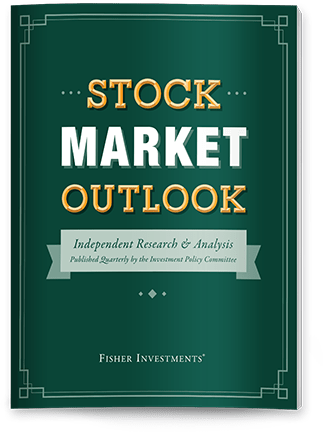Personal Wealth Management / Market Analysis
Why Headline Tariff Rates Tell You So Little
The lay of the land as reciprocal tariffs take effect.
So here we are, four months and five days after the Liberation Day reciprocal and blanket tariff announcement, and reciprocal tariffs are finally in effect, as of midnight. Despite the wild initial pullback, global stocks are now up 12.1% since President Donald Trump’s April 2 announcement.[i] The simple explanation: Markets rapidly priced worst-case scenario estimates, then recovered as things went better than expected. Not just with the temporary pause and a smattering of preliminary deals, but with abundant exemptions and evidence that companies are finding workarounds. As you navigate everyday life, you might find tariffs are a big new cost on selected goods, and we don’t dismiss that. But where broader markets are concerned, the whole spectrum of winners and losers, smaller-than-feared disruptions are a bullish tailwind.
Across the board, most new tariffs are below the rates threatened on Liberation Day. That includes tariffs on goods from the EU, Japan and a host of others, with the main exceptions being Brazil, India and, to a minor extent, the Philippines. Switzerland, too, but America doesn’t import that much in Swiss goods. Rates on Mexico and Canada are also higher on paper, but this is largely moot given most goods fall under the US-Mexico-Canada free-trade agreement (USMCA), exempting them.
Exhibit 1: Tariffs Are Up, but Less Than Threatened
Source: The White House, as of 8/7/2025.
But these are just headline rates. They apply to a lot of goods, including those Americans buy regularly, like clothing and cosmetics, which is a big reason tariffs feel so awful to many of us. As retailers work through the inventory they stockpiled before tariffs took effect and start looking to reorder, you will probably start to see the effects of higher tariff rates through higher prices and limited selection, especially with some small brands deciding to pull out of the US. If you order directly from international retailers, you will start seeing the effects at August’s end, when the tariff exemption on parcels valued at $800 or less ends. Retailers who handle tariff hassle for their clients by shipping Delivered Duty Paid (DDP) will likely raise their prices to cover it. If you shop from those who don’t, expect to start receiving invoices from the shipping carrier that you will have to pay before delivery. Pain, pain, pain. We feel it, too.
But this is more the exception than the rule. Liberation Day’s Executive Order applying reciprocal tariffs exempted over 1,000 goods, either through pre-existing trade agreements like the USMCA or through deference to the Harmonized Tariff Schedule (HTS). Little noticed, the order didn’t override, supersede or erase the HTS. Rather, its language was geared toward adding to the existing HTS framework, which lets a huge swath of imports receive legacy rates or even duty-free status if they very clearly match the HTS’s specific and technical legacy definition. Companies were also able to apply for specific exemptions. In the weeks that followed, as companies lobbied and countries negotiated, a number of other carveouts appeared. The administration clarified that tariffs on components and finished goods wouldn’t “stack” on top of one another. All in, a little over half of June imports were duty-free.
Yes, June was a hot minute ago, and the administration has announced more tariffs since then. But these, too, had exemptions—see our detailing of the myriad exemptions in the Brazil and copper tariffs last week. A new triple-digit semiconductor tariff announcement stole headlines this week, but it reportedly exempts all companies presently building facilities in the US. If that holds, the biggest manufacturers would all be exempt. While there is a new 40% tariff on “transshipped” goods, this seems unenforceable given the sheer impossibility of determining the offenders. After factoring and crunching all the numbers, we reckon the US’s effective tariff rate across all imports, averaged out, is a bit over 10%. That is annoying but not prohibitive, and it is far short of the worst-case scenario estimates.
We aren’t saying any of this is good. A lot of it strikes us as a hammer looking for a nail. Yes, the aim is to boost production here in the US. But coffee imports are tariffed, and Kona coffee can’t exactly serve the entire coffee-guzzling US population (of which your friendly MarketMinder editors are card-carrying members). Spices are tariffed, largely at the Indian (50%) or Vietnamese (20%) rates, and last we checked, the US had neither the climate nor the land for a robust cinnamon and nutmeg industry. Textiles are tariffed, yet we aren’t exactly seeing much clamor for the US to become a world-leading cotton or flax producer. No one seems to be lobbying for more land to go to cashmere goat farming. For all the focus on manufacturing, becoming self-sufficient (whatever that means) in all this stuff would require a return to an agrarian-heavy economy as well. If that is a sociological conversation this country decides to have, so be it, but that isn’t the sort of thing markets deal in or have an opinion on. Ditto the conversations on labor protections, wages and environmental rules that a labor-intensive manufacturing boom would require.
Markets do deal in—and have an opinion on—corporate earnings and how those will shape up over the next 3 – 30 months. Crucially, we still see a gap between sentiment and reality here. Yes, we are starting to see more awareness of the exemptions. They got a lot of ink and podcast space in The Wall Street Journal this week, for instance. We are also seeing a dose of cheer about the political and diplomatic implications of tariff deals, casting the US as “winner,” downplaying that the US and its people or businesses pay these tariffs and those costs are higher now. But there is still a good dose of gloom to counterbalance this. Companies taking tariff-induced earnings hits remain front-page news. We have seen it with numerous automakers this week, as well as a popular mass-market cosmetics company. And many, many others. Almost every time a company announces a hit or yanks back its earnings guidance because of tariff uncertainty, it dings sentiment. The market isn’t dismissing these developments, indicating tariff nerves are still pretty frayed overall.
So the potential for positive tariff surprise persists. Perhaps one day we will reach a point where sentiment overcorrects and markets are too dismissive of tariffs’ effects and consequences. Or maybe investors get carried away with relief-born optimism and dismiss tariffs’ insidious history of hamstringing business investment in the longer term. We are mindful of this possibility. But we aren’t there yet, rendering markets’ ongoing rise quite rational.
HT: Fisher Investments Research Analyst Tom Kirby and Research Specialists Kieran McCormack and Matt Hinesley
[i] Source: FactSet, as of 8/7/2025. MSCI World Index return with net dividends, 4/2/2025 – 8/6/2025.
If you would like to contact the editors responsible for this article, please message MarketMinder directly.
*The content contained in this article represents only the opinions and viewpoints of the Fisher Investments editorial staff.
Get a weekly roundup of our market insights
Sign up for our weekly e-mail newsletter.

You Imagine Your Future. We Help You Get There.
Are you ready to start your journey to a better financial future?

Where Might the Market Go Next?
Confidently tackle the market’s ups and downs with independent research and analysis that tells you where we think stocks are headed—and why.






